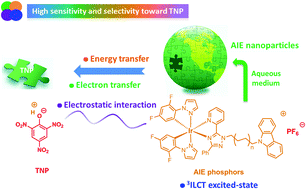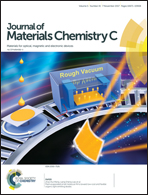Rational molecular design of aggregation-induced emission cationic Ir(iii) phosphors achieving supersensitive and selective detection of nitroaromatic explosives†
Abstract
Development of appropriate luminophores that can achieve effective sensing of nitroaromatic explosives is a crucial issue for our daily life safety and homeland security. Herein, supersensitive and highly selective detection of one nitroaromatic explosive, i.e. 2,4,6-trinitrophenol (TNP) in aqueous media, by taking advantage of rationally designed aggregation-induced emission (AIE) cationic Ir(III) phosphors with carbazole end-capped flexible ligands, is successfully realized. To decipher a detailed sensing mechanism and provide an alternative strategy for the molecular design in future, systematic experimental and theoretical investigations are performed. Comprehensive studies demonstrate that both electron and energy transfer, strong electrostatic interactions between TNP and cationic Ir(III) complexes, as well as specific intraligand charge transfer excited-state character are responsible for the high sensitivity and selectivity. We believe that the obtained results will pave a feasible avenue to construct novel phosphorescent materials that could be used for potentially efficient detection of TNP.



 Please wait while we load your content...
Please wait while we load your content...